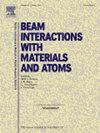IF 1.4
3区 物理与天体物理
Q3 INSTRUMENTS & INSTRUMENTATION
Nuclear Instruments & Methods in Physics Research Section B-beam Interactions With Materials and Atoms
Pub Date : 2025-02-05
DOI:10.1016/j.nimb.2025.165631
引用次数: 0
摘要
我们介绍了NaI(Tl)和CsI(Tl)探测器模块的余辉特征测量结果,这是背景和瞬变观测器(BTO)任务探测器贸易研究的一部分。BTO 是 NASA 的一个学生合作项目,将于 2027 年在康普顿光谱仪和成像仪(COSI)小型探测器任务中飞行。本研究使用的探测器为圆柱形,高和直径均为 5.1 厘米,由硅光电倍增管(SiPM)读出。我们在日本的 HIMAC 加速器上进行了一次辐照试验,用 230 MeV/u 的氦束(He 束)和 350 MeV/u 的碳束(C 束)对闪烁体进行了辐照。我们发现,铯和碘闪烁体在接受 C 和 He 射束辐照时都会出现余辉。CsI 晶体显示出更强的余辉强度,在初始粒子脉冲之后,C 的余辉脉冲平均为 2.40 毫秒,而 He 的余辉脉冲平均为 0.9 毫秒。对于 C 和 He 而言,CsI 中余辉脉冲的持续时间分别是 NaI 中余辉信号持续时间(0.28 毫秒和 0.16 毫秒)的 8.6 倍和 5.6 倍。虽然 CsI 具有光产率高和辐射硬度高的优点,但 CsI 探测器中更强的余辉增加了电子设备的复杂性,导致每个余辉事件的死区时间增加了 7 倍或能量阈值提高了 3 倍。我们利用测得的死区时间来预测像 BTO 这样的仪器在低地球轨道上因余辉诱发事件而损失的观测时间。我们模拟了类似 BTO 轨道的本底率,发现整个双探测器系统的总值为 114 计数/秒。根据 HIMAC 实验中的粒子能量,我们确定在 NaI 和 CsI 探测器中分别每隔 ∼70 s 和 ∼1.4 s 就会发生一次能量足以产生余辉信号的事件。因此,我们得出结论,NaI 是 BTO 飞行任务的更好选择。本文章由计算机程序翻译,如有差异,请以英文原文为准。
A study of afterglow signatures in NaI and CsI scintillator modules for the background and transient observer instrument on COSI
We present measurements of the afterglow signatures in NaI(Tl) and CsI(Tl) detector modules as part of the Background and Transient Observer (BTO) mission detector trade-study. BTO is a NASA Student Collaboration Project flying on the Compton Spectrometer and Imager (COSI) Small Explorer mission in 2027. The detectors utilized in this study are cylindrical in shape with a height and diameter of 5.1 cm and were read out by silicon photomultipliers (SiPMs). We conducted a radiation campaign at the HIMAC accelerator in Japan where the scintillators were irradiated with a 230 MeV/u helium beam (He beam) and 350 MeV/u carbon beam (C beam). We find that both the CsI and NaI scintillators exhibit afterglow signatures when irradiated with the C and He beams. The CsI crystal exhibits a stronger afterglow intensity with afterglow pulses occurring for an average 2.40 ms for C and 0.9 ms for He after the initial particle pulse. The duration of afterglow pulses in CsI is 8.6 and 5.6 the afterglow signal duration in NaI for C and He (0.28 ms and 0.16 ms, respectively). Although CsI has advantages such as a higher light yield and radiation hardness, the stronger afterglows in the CsI detector increase the complexity of the electronics and lead to a larger dead time per afterglow event or a higher energy threshold value. We use the measured dead times to predict the amount of observing time lost to afterglow-inducing events for an instrument like BTO in low Earth orbit. We simulate the background rates in a BTO-like orbit and find a total value of 114 counts/s for the full two-detector system. Based on the particle energies in the HIMAC experiment, we then determine that an event with sufficient energy to produce an afterglow signal occurs once every 70 s and 1.4 s in NaI and CsI detectors, respectively. Thus, we conclude that NaI is the better choice for the BTO mission.
求助全文
通过发布文献求助,成功后即可免费获取论文全文。
去求助
来源期刊
CiteScore
2.80
自引率
7.70%
发文量
231
审稿时长
1.9 months
期刊介绍:
Section B of Nuclear Instruments and Methods in Physics Research covers all aspects of the interaction of energetic beams with atoms, molecules and aggregate forms of matter. This includes ion beam analysis and ion beam modification of materials as well as basic data of importance for these studies. Topics of general interest include: atomic collisions in solids, particle channelling, all aspects of collision cascades, the modification of materials by energetic beams, ion implantation, irradiation - induced changes in materials, the physics and chemistry of beam interactions and the analysis of materials by all forms of energetic radiation. Modification by ion, laser and electron beams for the study of electronic materials, metals, ceramics, insulators, polymers and other important and new materials systems are included. Related studies, such as the application of ion beam analysis to biological, archaeological and geological samples as well as applications to solve problems in planetary science are also welcome. Energetic beams of interest include atomic and molecular ions, neutrons, positrons and muons, plasmas directed at surfaces, electron and photon beams, including laser treated surfaces and studies of solids by photon radiation from rotating anodes, synchrotrons, etc. In addition, the interaction between various forms of radiation and radiation-induced deposition processes are relevant.

 求助内容:
求助内容: 应助结果提醒方式:
应助结果提醒方式:


